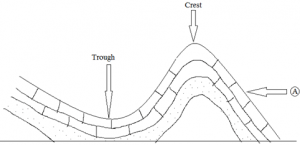This set of Engineering Geology Multiple Choice Questions & Answers (MCQs) focuses on “Parts of a Fold”.
1. What are the undulations or bends developed in rocks called?
a) Faults
b) Joints
c) Folds
d) Uncomformity
View Answer
Explanation: Folds may be defined as undulations or bends or curvatures developed in the rocks of the crust as a result of stresses to which these rocks have been subjected from time to time in the past history of the Earth.
2. Folds develop in which type of rock?
a) Igneous rock
b) Sedimentary rock
c) Metamorphic rock
d) Any type of rock
View Answer
Explanation: The folds may develop in any type of rock and may be of any shape and flexures.
3. Which type of deformation is folding?
a) Brittle
b) Ductile
c) Tensile
d) Malleable
View Answer
Explanation: In general, folding is a ductile type of deformation experienced by the rocks compared to the brittle deformation where the rocks actually get broken and displaced when stressed.
4. Folding is ________ process.
a) Very slow
b) Rapid
c) Quick
d) Moderate rate
View Answer
Explanation: Folding is a very slow geological process and indicates an effort of the rocks in a particular environment to adjust themselves to the changing force fields operating on, within or around them.
5. Which among the following is not a part of fold?
a) Limbs
b) Hinge
c) Axis of fold
d) Height of fold
View Answer
Explanation: Parts of a fold include, limbs, hinge, axis of a fold, plunge of a fold and crest & trough. Height of fold is not referred as its part.
6. The minimum number of limbs for a fold are _____________
a) 1
b) 2
c) 3
d) 4
View Answer
Explanation: An individual fold will have a minimum of two limbs but when the folds occur in groups, as this is common, a middle limb will be common to two adjacent folds.
7. The point where the curvature is maximum is ________
a) Hinge
b) Axial surface
c) Nucleus
d) Fold point
View Answer
Explanation: In a folded layer, a point can be found where curvature is maximum and one limb ends and the other limb starts from that point. This is the hinge point.
8. When the plunge said to be zero, then the axis of the fold is said to be ____________
a) Vertical
b) Horizontal
c) Inclined at 60° to the horizontal
d) Inclined at 60° to its normal.
View Answer
Explanation: Axis is a line and plunge is the angle which the line makes with a horizontal. A fold having a horizontal axis will obviously have a zero plunge.
9. The crest and trough may or may not coincide with the axis.
a) True
b) False
View Answer
Explanation: The line running through the highest points in an uparched fold defines the crest and similarly the line running through the lowest point in a downarched fold makes its trough. The crest and trough may or may not coincide with the axis of the fold.
10. What is the axis of a fold?
a) Line drawn normal to the hinge line
b) Line drawn at 60° to hinge line
c) Line drawn parallel to hinge line
d) Line which doesn’t pass through hinge line.
View Answer
Explanation: Axis of fold is defined as a line drawn parallel to the hinge line of a fold. In other words, line representing the intersection of the axial plane of a fold with any bed of the fold.
11. How is the plunge of a fold measured?
a) Direction
b) Degree
c) Depth
d) Both direction and degree
View Answer
Explanation: The plunge is measured like a dip of a bedding plane, both in terms of the direction of plunge and degree of plunge.
12. An axial plane can be vertical, inclined or horizontal in nature.
a) False
b) True
View Answer
Explanation: An axial plane is that imaginary plane that passes through all the points of maximum curvature in a folded sequence. It may be vertical, inclined or horizontal in nature.
13. Identify the part labelled “A” in the below figure.

a) Limb
b) Hinge
c) Axis of fold
d) Plunge
View Answer
Explanation: Limbs are the sides or flanks of a fold. The part labelled “A” in the figure is a limb of fold.
14. Which of the following about axial plane is not true.
a) Axial plane is imaginary
b) Axial plane may be vertical, inclined or horizontal
c) Axial plane may be planar or non-planar
d) Axial plane need not pass through all points of maximum curvature in a folded sequence
View Answer
Explanation: An axial plane is defined as an imaginary plane that passes through all the points of maximum curvature in a folded sequence. It may be vertical, inclined or horizontal. Also, it can be either planar or non-planar.
Sanfoundry Global Education & Learning Series – Engineering Geology.
To practice all areas of Engineering Geology, here is complete set of 1000+ Multiple Choice Questions and Answers.
If you find a mistake in question / option / answer, kindly take a screenshot and email to [email protected]
- Apply for Mining Engineering Internship
- Check Mining Engineering Books
- Practice Mining Engineering MCQs
- Check Civil Engineering Books
- Check Engineering Geology Books
